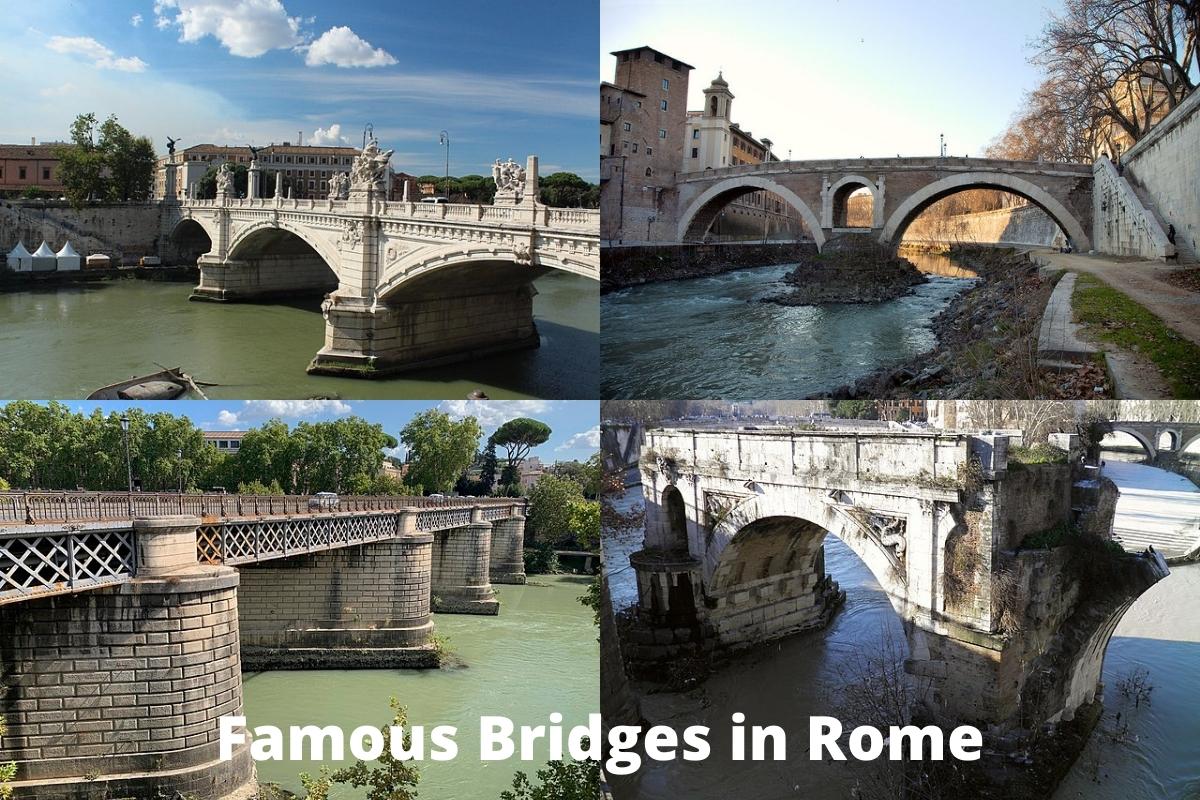Rome is in central Italy and serves as its capital city. Etruscan settlers founded Rome around the 8th century BC. We know the city of Rome as one of the largest cities in Italy.
It is also famous for its art, culture, and ruins. There are also several lesser-known attractions and bridges located around the city.
Some of the most famous bridges in Rome are well-loved by visitors and residents alike. Like other Roman artifacts, some bridges in this region date back thousands of years.
Some bridges frequented more often include the Ponte Milvio (the busiest bridge in Rome), Ponte della Musica-Armando Trovajoli, and Ponte Sant’Angelo.
Read on to learn about the history of some of the most famous bridges in Rome.
Famous Bridges in Rome
1. Ponte Sant’Angelo
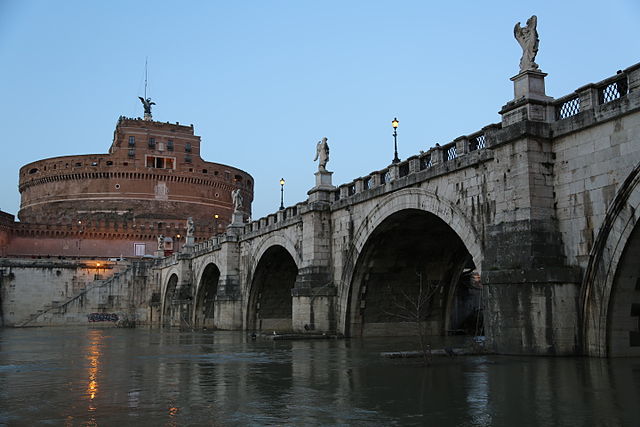
The Ponte Sant’Angelo, also known as the Aelian Bridge or Pons Aelius, is a Roman bridge in Rome, Italy, built in 134 AD by Roman Emperor Hadrian to connect the city center to his newly erected tomb, today known as the towering Castel Sant’Angelo.
The bridge is made of travertine marble and crosses the Tiber with five arches, three of which are Roman; it was accessible from the river by a ramp.
Also Read: Landmarks in Rome
The two Roman ramps that connected the bridge to the two banks were removed at the end of the nineteenth century as part of the Lungotevere construction, and two arches comparable to the Roman ones were erected in their place.
The Lungotevere on the right bank between the bridge and the castle became a pedestrian space for the Great Jubilee in 2000.
The bridge is currently only for pedestrians and offers a beautiful view of Castel Sant’Angelo. It connects the rioni of Ponte (named after the bridge) and Borgo, to whom the bridge is administratively assigned.
2. Ponte Milvio
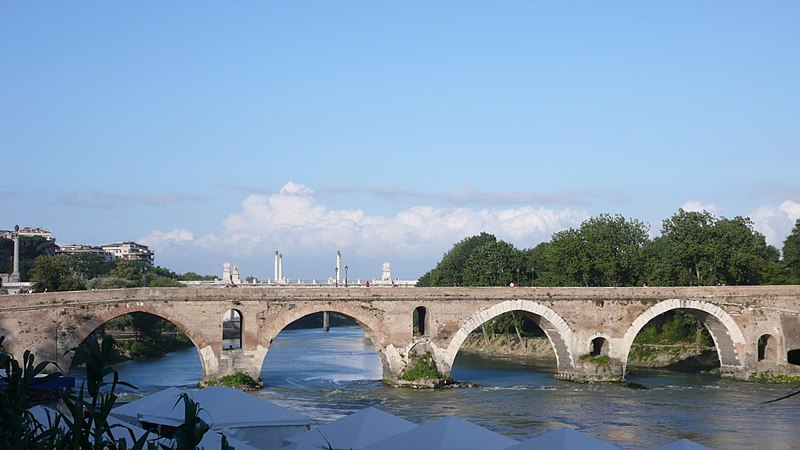
The Milvian (or Mulvian) Bridge (Italian: Ponte Milvio or Ponte Molle) is a Tiber-spanning bridge in northern Rome, Italy.
It was an economically and strategically vital bridge during the Roman Empire’s reign, and it was the location of the legendary Battle of the Milvian Bridge in 312, which resulted in Constantine’s imperial control.
After defeating the Carthaginian army in the Battle of the Metaurus, consul Gaius Claudius Nero erected a bridge in 206 BC.
In 109 BC, censor Marcus Aemilius Scaurus demolished the ancient bridge and constructed a new stone bridge in its place.
Letters from the Catiline conspirators were intercepted here in 63 BC, enabling Cicero to recite them before the Roman Senate the following day.
In the legendary Battle of the Milvian Bridge in AD 312, Constantine I overcame his stronger foe Maxentius between this bridge and Saxa Rubra.
During the Middle Ages, a monk called Acuzio restored the bridge, and in 1429, Pope Martin V commissioned a great architect, Francesco da Genazzano, to fix it since it was crumbling.
The bridge was altered in the 18th and 19th centuries by two architects, Giuseppe Valadier and Domenico Pigiani.
The bridge was severely destroyed by Garibaldi’s soldiers in an effort to obstruct a French invasion in 1849, and was subsequently reconstructed by Pope Pius IX in 1850.
3. Ponte Sisto
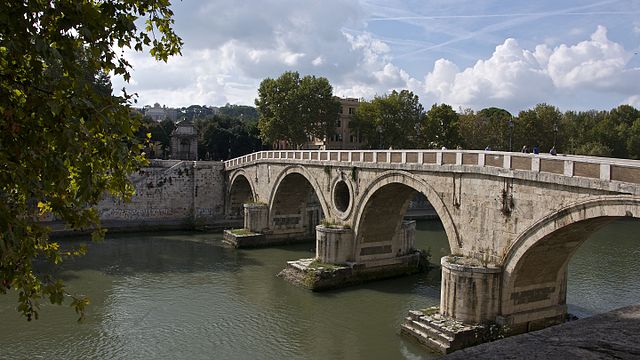
Ponte Sisto is a bridge that spans the Tiber River in Rome’s old center. It runs from Via dei Pettinari in Regola to Piazza Trilussa in Trastevere.
The present bridge was built between 1473 and 1479 by Pope Sixtus IV (r. 1471-84), for whom it is called, and was commissioned from the architect Baccio Pontelli, who reused the foundations of a previous Roman bridge, the Pons Antoninus, which had been demolished during the early Middle Ages.
Pedestrians are now the only mode of transportation on the bridge.
Sixtus was also aware of the calamity that happened during the Jubilee of 1450 due to the congestion of the Bridge of S. Angelo, which was the only possible means of connection with St. Peter’s.
4. Pons Aemilius
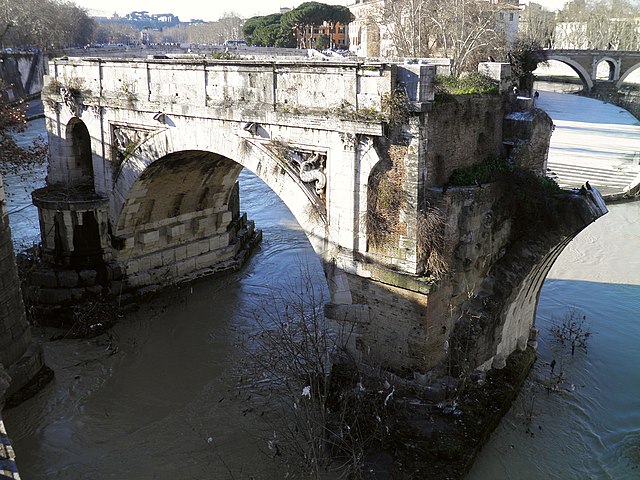
The Pons Aemilius Bridge was a Roman bridge in Rome, Italy. It linked the Viminal Hill to the Quirinal Hill. The original stone structure had several arches and spandrels, but only one arch remains today. Four massive round pillars support it.
The Roman statesman and general Marcus Aemilius Lepidus built the bridge in 142 BC as part of a massive project to beautify Rome.
It had three arches at the time of its original construction, but only one survives today. The Pons Aemilius Bridge originally comprised six round pillars on each side, but only four remain from this initial construction.
It underwent several reconstructions during its long history, including being completely rebuilt in 70 AD following an episode where the bridge collapsed because of heavy rain. They named the bridge for Pons Aemilius, a general in the Roman army who fought in the First Punic War against Carthage.
5. Pons Fabricius
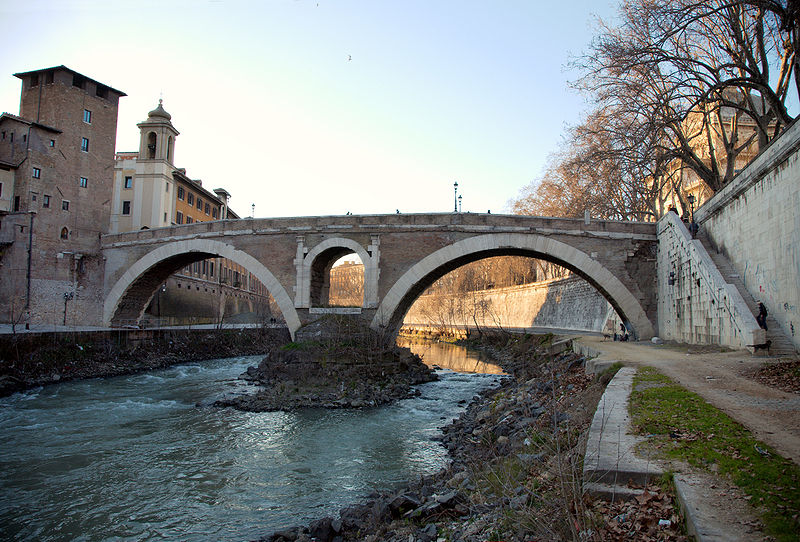
The Pons Fabricius (Italian: Ponte Fabricio, “Fabrician Bridge”) or Ponte dei Quattro Capi is the oldest Roman bridge still in use in Rome, Italy.
It was built in 62 BC and spans half of the Tiber River, from the Campus Martius on the east bank to Tiber Island in the center (the Pons Cestius is west of the island).
Quattro Capi (“four heads”) refers to the two marble pillars of the two-faced Janus herms on the parapet, which were relocated here in the 14th century from the adjacent Church of St Gregory (Monte Savello).
6. Ponte della Musica
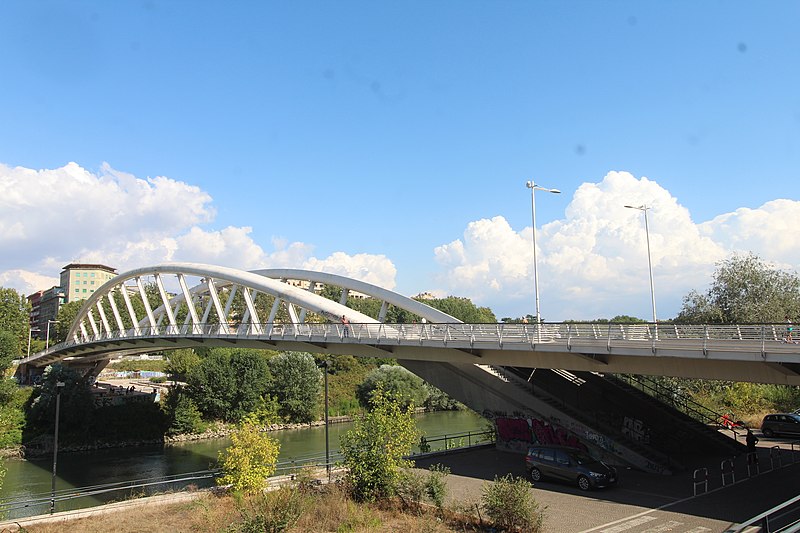
The Ponte della Musica-Armando Trovajoli is a bridge in Rome that spans the Tiber between the Della Vittoria and Flaminio districts, suspended between the Lungotevere Flaminio and the Cadorna.
The bridge links the Auditorium Parco della Musica, the park of Villa Glori, the MAXXI museum, and the Olympic theater to the Foro Italico sports complex, the youth hostel, the Monte Mario green area, the Genius Museum, and the Rai auditorium.
It is made of steel and reinforced concrete and is intended for cycling, pedestrians, and public transportation. It was opened in May 2011 as the Bridge of Music, but two years later it was named in honour of Armando Trovajoli, taking its present name.
The bridge’s modern design incorporates several elements into its construction, including steel, high-strength concrete, reinforced concrete, and wood. It features a 190-meter-long arched construction with a maximum width of 22 in the center section and 14 at both ends.
The principal architectural element of the work is the two huge lowering steel arches that encircle and support the metal deck; there is no horizontal connection between them in the region above.
This aesthetic approach allowed for a distinct lightness of the bridge, as well as “separation” of the center roadway from the two pedestrian walkways that overlook the Tiber on each side.
7. Ponte Vittorio Emanuele II
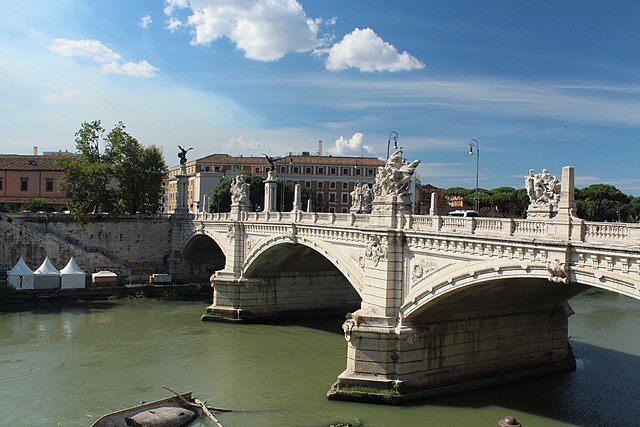
Ponte Vittorio Emanuele II is a bridge in Rome built in 1886 to plans by architect Ennio De Rossi. Construction was delayed, and it did not open until 1911.
The Tiber Bridge links the old heart of Rome (Corso Vittorio Emanuele, down whose axis the bridge runs, and Piazza Paoli at the bridgehead) with the Rione Borgo and the Vatican City, near to what remains of the ancient Pons Neronianus.
The bridge honouring Vittorio Emanuele II of Italy is built in three arches and spans 108 meters.
It is adorned at the ends with large allegorical travertine sculptural groups and above each of the piers with lofty socles supporting gigantic bronze winged Victories.
8. Pons Cestius
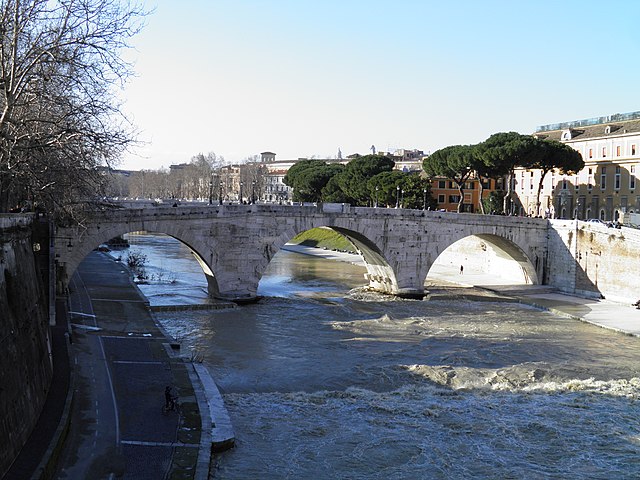
The Pons Cestius is a historic Roman bridge in Rome, Italy that connects the right bank of the Tiber to the west of Tiber Island.
The bridge was reconstructed and called the Pons Gratiani in Late Antiquity.
It is also known in Italian as Ponte San Bartolomeo, which translates as “Bridge of Saint Bartholomew.”
Only around one-third of the current stone bridge is of historic material, since it was completely rebuilt and enlarged in the nineteenth century, after multiple previous repairs.
During the Tiber channel embankment in 1888-1892, the construction of the walls and boulevards (the lungoteveri) along the river prompted the destruction of the Roman bridge and the restoration of a new bridge.
The original bridge, which had two modest arches on each side of a large center span, was just too short. The current bridge, with three huge arches, was built in its place, with the central arch recycling around two-thirds of the old material.
This era accounts for two-thirds of the current construction, with just around a third of the building constructed from pre-modern materials.
The bridge was 80.4 metres (264 feet) long when it was rebuilt in the nineteenth century, with the original central arch flanked by two more arches of equal span.
9. Ponte Palatino
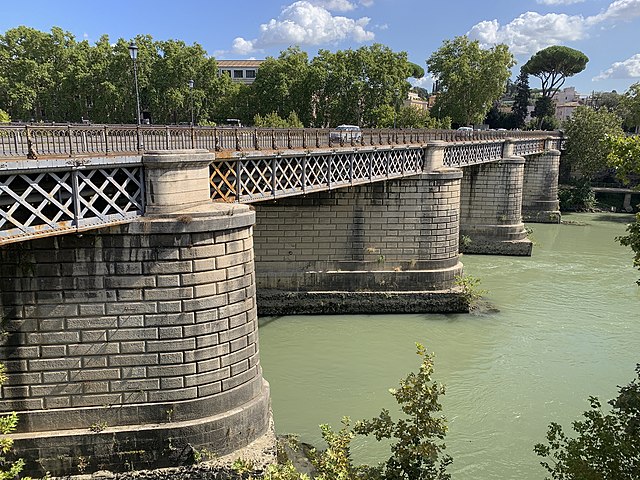
Angelo Vescovali designed the bridge, which was erected between 1886 and 1890 in place of the partly ruined 2,200-year-old Pons Aemilius (also called Ponte Rotto, “Broken Bridge”).
The historic three-arch bridge was damaged by a flood in 1598, and another arch was removed by Vescovali in 1887 to make way for the Ponte Palatino, leaving the Pons Aemilius with only a single arch in the middle of the river, near to the contemporary bridge.
The building is named after the Palatine Hill, whose slopes it rises. The bridge connects the Forum Boarium to Piazza Castellani, in front of the Tiber Island; the name English refers to the left-hand traffic flow that exists on it, as it does in the United Kingdom.
It is 155 meters (509 feet) long and has five masonry piers with a metal top surface.
10. Ponte Flaminio
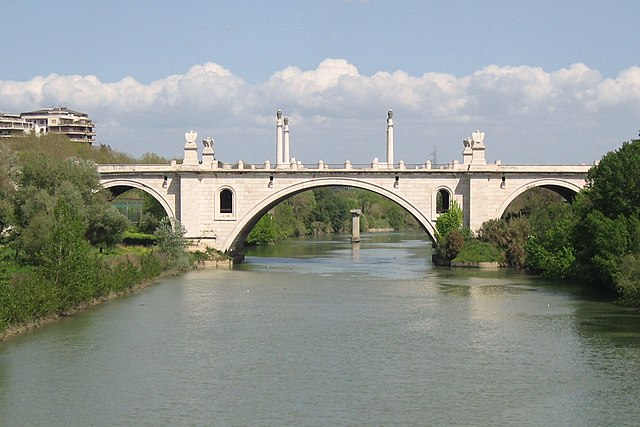
Ponte Flaminio is a bridge in Rome, Italy, that connects Corso di Francia, Quartieri Parioli, Tor di Quinto, and Vigna Clara.
The bridge was closed to motor vehicles in the early 1960s owing to a structural fault on the fifth pylon, which caused a sinking of the highway; rehabilitation work was handed to engineers Arrigo Carè and Giorgio Giannelli, and a Bailey bridge was built slightly upstream to absorb traffic.
The bridge reopened in 1964, but the building of the Grande Raccordo Anulare and the Fiumicino Airport had significantly limited its usefulness as Rome’s major entry.
The bridge, which spans 254.94 metres (836.4 ft) in length by 27 metres (89 ft) in width, is composed of concrete and totally coated with Roman travertine in warm tones of white.
On the two huge sidewalks elevated by picturesque stairways, cylindrical stones and stems bearing eagles and street lighting rise.
Its profile is reminiscent of the neighboring Milvian Bridge, with massively exaggerated proportions, resulting in a gigantic and intimidating structure.

